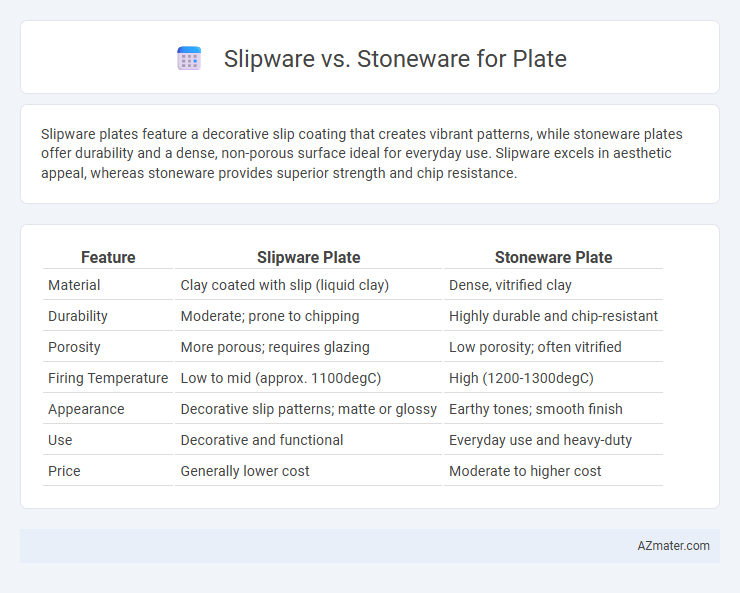Slipware plates feature a decorative slip coating that creates vibrant patterns, while stoneware plates offer durability and a dense, non-porous surface ideal for everyday use. Slipware excels in aesthetic appeal, whereas stoneware provides superior strength and chip resistance.
Table of Comparison
| Feature | Slipware Plate | Stoneware Plate |
|---|---|---|
| Material | Clay coated with slip (liquid clay) | Dense, vitrified clay |
| Durability | Moderate; prone to chipping | Highly durable and chip-resistant |
| Porosity | More porous; requires glazing | Low porosity; often vitrified |
| Firing Temperature | Low to mid (approx. 1100degC) | High (1200-1300degC) |
| Appearance | Decorative slip patterns; matte or glossy | Earthy tones; smooth finish |
| Use | Decorative and functional | Everyday use and heavy-duty |
| Price | Generally lower cost | Moderate to higher cost |
Introduction to Slipware and Stoneware Plates
Slipware plates feature a decorative technique where liquid clay, or slip, is applied to the surface, creating intricate patterns and a smooth finish prized for aesthetic appeal. Stoneware plates are fired at high temperatures, resulting in a dense, durable, and chip-resistant material ideal for everyday use and resistant to thermal shock. Both slipware and stoneware plates offer functional and artistic qualities, with slipware emphasizing decorative elegance and stoneware prioritizing durability and practicality.
Historical Background of Slipware and Stoneware
Slipware, dating back to the Neolithic era, evolved through ancient civilizations such as the Romans and Chinese, characterized by its use of liquid clay slip to decorate ceramics with vibrant patterns and textures. Stoneware, developing prominently in East Asia around 3,000 years ago and later in Europe during the Middle Ages, is recognized for its durability, dense, vitrified body, and ability to withstand high firing temperatures. Both slipware and stoneware reflect the cultural and technological advancements of their time, with slipware emphasizing decorative artistry and stoneware prioritizing functional robustness.
Key Material Differences: Slipware vs Stoneware Plates
Slipware plates are crafted by applying a liquid clay slip over a porous earthenware body, resulting in a decorative surface with vibrant colors and intricate patterns but higher porosity and lower durability. Stoneware plates, made from dense, vitrified clay fired at higher temperatures around 1200-1300degC, offer superior strength, chip resistance, and non-porous surfaces ideal for everyday use. The fundamental material difference lies in slipware's porous, absorbent earthenware base contrasted with stoneware's dense, non-porous ceramic body, affecting durability, water absorption, and suitability for functional tableware.
Aesthetic Appeal: Visual Characteristics Compared
Slipware plates showcase a distinctive, rustic charm through their intricate patterns and vibrant glazes created by applying liquid clay, resulting in a tactile, handmade appearance. Stoneware plates offer a more refined, uniform aesthetic with dense, smooth surfaces that emphasize natural earth tones and subtle textures. Both materials excel in visual appeal, but slipware emphasizes decorative artistry while stoneware highlights understated elegance.
Durability and Strength: Which Plate Lasts Longer?
Stoneware plates exhibit superior durability and strength compared to slipware, as they are fired at higher temperatures, resulting in a denser, more vitrified material that resists chipping and cracking. Slipware, often more porous and less dense due to its decorative slip coating, tends to be more vulnerable to wear over time. Therefore, stoneware plates generally last longer and maintain their structural integrity better under frequent use.
Functional Uses: Everyday Dining and Special Occasions
Slipware plates offer a unique, decorative appearance with colorful slip designs that enhance table settings during special occasions, while also being durable enough for everyday dining due to their fired clay composition. Stoneware plates are known for their robust, non-porous surface that withstands daily use, resisting chipping and staining, making them ideal for routine meals and casual entertaining. Both materials provide functional versatility, but slipware's artistic appeal makes it particularly favored for festive and formal dining experiences.
Glazing and Surface Texture: Tactile Experiences
Slipware plates showcase a smooth but slightly textured surface due to the liquid clay slip applied before firing, creating unique, often decorative patterns under the glaze that add rich tactile and visual interest. Stoneware plates typically feature a sturdier, denser body with a more uniform and subtly textured surface, often enhanced by a durable, glossy or matte glaze that provides a smooth touch and excellent resistance to chipping. The glazing on slipware emphasizes artistic detail and variation in texture, while stoneware glazing focuses on durability and a sleek finish suitable for everyday use.
Maintenance and Care Needs for Each Plate Type
Slipware plates require gentle hand washing with mild soap to preserve their decorative slip coating, avoiding abrasive scrubbers that could damage the surface. Stoneware plates are more durable and often dishwasher-safe, though hand washing with warm, soapy water is recommended to maintain their glaze and prevent chipping. Both types benefit from avoiding sudden temperature changes to prevent cracking and extend their lifespan.
Environmental Impact and Sustainability
Slipware plates typically involve glazing with a liquid clay mixture that often contains natural minerals, offering a biodegradable and eco-friendly finish when produced using sustainable sourcing methods. Stoneware plates are made from dense, non-porous clay fired at high temperatures, enhancing durability and longevity, which reduces the need for frequent replacements and lowers environmental waste. The energy-intensive firing process of stoneware impacts sustainability, but its robustness and recyclability contribute positively to long-term ecological considerations.
Choosing the Right Plate: Slipware or Stoneware?
Choosing the right plate depends on your preferences for durability and aesthetics; slipware plates are known for their unique decorative patterns created by applying liquid clay slips, making each piece distinct and artistic. Stoneware plates offer superior strength and chip resistance due to their dense, vitrified structure, making them ideal for everyday use and long-term durability. Consider slipware for casual serving with a handcrafted feel, while stoneware suits both functional and elegant table settings requiring robust performance.

Infographic: Slipware vs Stoneware for Plate
 azmater.com
azmater.com